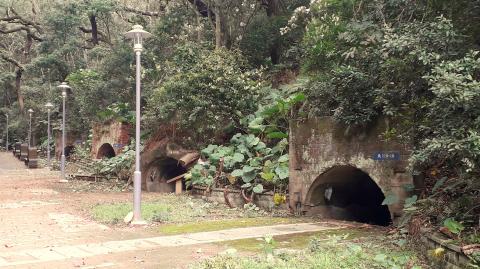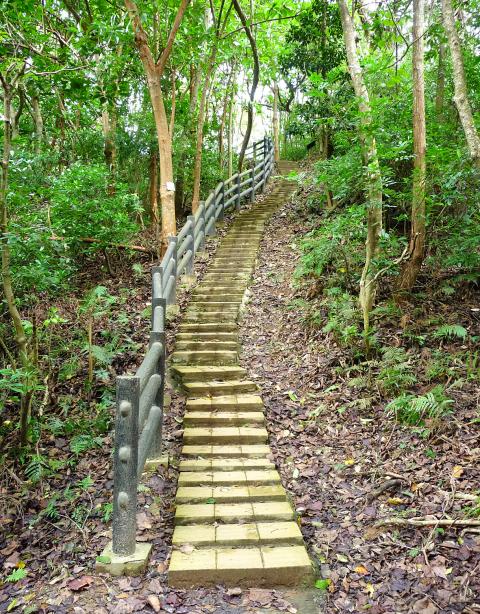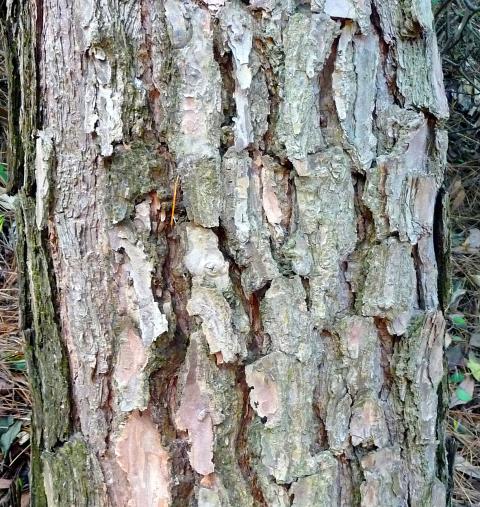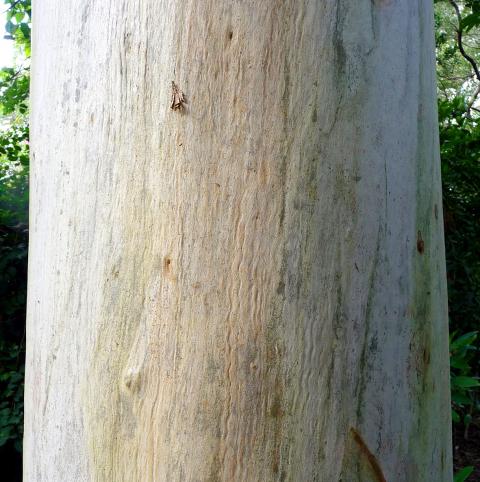I was beginning to wonder if Mother Nature had it in for me. For the second time in less than 10 minutes, a gust of wind dislodged a branch from the canopy, and it clattered down right where I’d been standing a few moments earlier.
Hsinchu is famously windy, and I was in Gaofeng Botanical Garden (高峰植物園) on an exceptionally blowy winter’s day. Each time the sun came out, clouds maneuvered to obscure it within seconds. Stands of bamboo pitched like galleons rounding Cape Horn. The nonstop clattering reminded me of kendo training sessions.
I’d entered the garden from Baoshan Road (寶山路), 650m west of the southern entrance to National Tsing Hua University (國立清華大學). There’s another entrance at the end of Lane 160, Gaocui Road (高翠路160巷). From the latter, follow the gravel path until you reach a gazebo equipped with a drinking-water machine. From there, you can continue straight ahead, or turn right and go anticlockwise around the 16-hectare garden.

Photo by Steven Crook
My own clockwise 90-minute hike through Gaofeng Botanical Garden had begun at the pedestrian bridge which crosses Baoshan Road, linking the garden with the often-crowded hiking area known as Eighteen Peaks Mountain (十八尖山). Given the speed and quantity of traffic on the road, this bridge has undoubtedly saved lives.
Following a path beside a tiny creek, I snapped some pictures of a colorful butterfly, not knowing it would be one of the very few insects I’d see during my early-afternoon hike. It wasn’t just the wind; surely the cold was another reason why I saw hardly any birds or lizards.
In the absence of moving creatures, including other humans, I decided to focus on the trees, especially their different barks. Established in 1932 by the Japanese colonial authorities then controlling Taiwan as a tree nursery to supply seedlings to experimental forests, Gaofeng Botanical Garden is a good place to do this. It’s now home to an impressive 150-plus tree species, many of which are labeled with their Chinese and scientific names.

Photo by Steven Crook
The first tree I paid close attention to was a waist-high specimen of Sapindus mukorossi, known in different parts of Asia as Indian soapberry or Chinese soapberry.
In the rural Taiwan of yesteryear, soap made from its seeds was used not just to do laundry, but also for washing hair; chemicals in the seeds help remove head lice. More recently, scientists have discovered that the seeds can be used to make both biodiesel and a surfactant (a compound lowering surface tension) which could help extract oil from existing reserves by increasing the oil’s mobility.
A section of trail in the heart of the botanical garden has been dubbed the Formosan Sweetgum Roadway (楓香景觀步道). It’s lined with Liquidambar formosana trees, the leaves of which display delightful shades of red, orange and yellow during the autumn. Despite its name, this species isn’t endemic to Taiwan, growing as far away as Laos.

Photo by Steven Crook
Such is the density of trees and other foliage that at only one spot was I able to see the office blocks and apartment buildings of Hsinchu.
In terms of their barks, two of the most interesting trees inside the garden were a slash pine (Pinus elliottii) and a lemon-scented gum (Corymbia citriodora). The former is native to the southeastern US; the latter comes from the northeast of Australia.
The slash pine is so named not for its craggy, scabrous bark — which looks as though an angry person took an axe to it — but rather because it grows best in the swamplands colloquially known as “slashes.” It was once used to produce resin and turpentine.

Photo by Steven Crook
The gum tree, by contrast, had unnaturally pale yet beautifully smooth bark that I could happily touch all day long. It would feel wonderful underfoot, but perhaps wouldn’t be the easiest flooring surface to keep clean.
I also look closely at a Cerbera manghas tree. I realized it is a species worth knowing about after I got home and found a medical research paper titled “Sea Mango Cardiac Intoxication.”
In coastal Taiwan, the paper states, Cerbera manghas “is a very common plant and readily accessible. The fruit… turns bright red at maturity and appears very much like the edible mango... It is quite possible to inadvertently ingest the fruit and become intoxicated.”

Photo by Steven Crook
In Hawaii, one nickname for the fruit is “suicide apple.” When ingested, the leaves are also highly poisonous. Hunter-gatherers have been known to tip their arrows and darts with Cerbera manghas sap, to incapacitate animals.
The bark had several vertical fissures. Looking at images online, I’ve not been able to determine if this is normal or not — but I did learn that this part of the tree has been used as a laxative and antipyretic (a fever-reducing substance), to treat ringworm and to induce abortions.
Leaving the botanical garden by the way I came in, I headed down the hill toward the city center. After covering less than 100m, I stumbled across a sign for Eighteen Peaks Mountain Air-raid Shelter Trail (十八尖山防空洞步道).
This probably deserves a look, I thought. I turned off the road and immediately saw a row of eight tunnel mouths facing westish at slightly different angles. There were subtle differences in the dimensions, designs, and materials — concrete and brick, mostly — so I’m guessing they weren’t all built at the same time. Because I lacked a flashlight, I couldn’t tell how big they are, or if they connect to one another.
Standing close to one of the shelters, I heard a sudden crash. I looked up, half expecting to see a Formosan macaque retreating through the treetops. But no: The woodland spirits were having yet another go at me.
A tree limb longer and thicker than my leg tumbled down the slope in my direction until it became entangled in the undergrowth. If enjoying the outdoors means there’s a danger of getting brained by a branch, it’s a risk I’m willing to take.
Steven Crook has been writing about travel, culture, and business in Taiwan since 1996. He is the co-author of A Culinary History of Taipei: Beyond Pork and Ponlai, and author of Taiwan: The Bradt Travel Guide, the third edition of which has just been published.

Nov. 11 to Nov. 17 People may call Taipei a “living hell for pedestrians,” but back in the 1960s and 1970s, citizens were even discouraged from crossing major roads on foot. And there weren’t crosswalks or pedestrian signals at busy intersections. A 1978 editorial in the China Times (中國時報) reflected the government’s car-centric attitude: “Pedestrians too often risk their lives to compete with vehicles over road use instead of using an overpass. If they get hit by a car, who can they blame?” Taipei’s car traffic was growing exponentially during the 1960s, and along with it the frequency of accidents. The policy

Hourglass-shaped sex toys casually glide along a conveyor belt through an airy new store in Tokyo, the latest attempt by Japanese manufacturer Tenga to sell adult products without the shame that is often attached. At first glance it’s not even obvious that the sleek, colorful products on display are Japan’s favorite sex toys for men, but the store has drawn a stream of couples and tourists since opening this year. “Its openness surprised me,” said customer Masafumi Kawasaki, 45, “and made me a bit embarrassed that I’d had a ‘naughty’ image” of the company. I might have thought this was some kind

What first caught my eye when I entered the 921 Earthquake Museum was a yellow band running at an angle across the floor toward a pile of exposed soil. This marks the line where, in the early morning hours of Sept. 21, 1999, a massive magnitude 7.3 earthquake raised the earth over two meters along one side of the Chelungpu Fault (車籠埔斷層). The museum’s first gallery, named after this fault, takes visitors on a journey along its length, from the spot right in front of them, where the uplift is visible in the exposed soil, all the way to the farthest

The room glows vibrant pink, the floor flooded with hundreds of tiny pink marbles. As I approach the two chairs and a plush baroque sofa of matching fuchsia, what at first appears to be a scene of domestic bliss reveals itself to be anything but as gnarled metal nails and sharp spikes protrude from the cushions. An eerie cutout of a woman recoils into the armrest. This mixed-media installation captures generations of female anguish in Yun Suknam’s native South Korea, reflecting her observations and lived experience of the subjugated and serviceable housewife. The marbles are the mother’s sweat and tears,